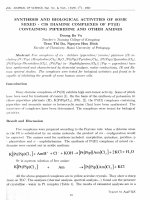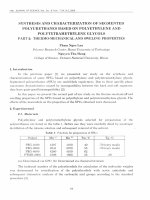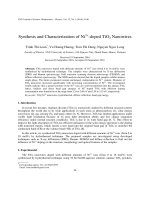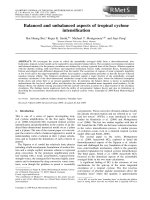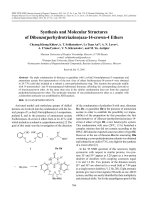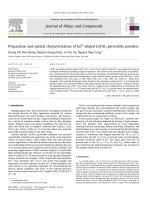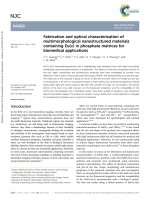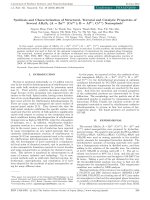DSpace at VNU: Synthesis and molecular structures of dibenzo(perhydrotriazino)aza-14- crown-4 ethers
Bạn đang xem bản rút gọn của tài liệu. Xem và tải ngay bản đầy đủ của tài liệu tại đây (246.16 KB, 5 trang )
ISSN 1070-4280, Russian Journal of Organic Chemistry, 2011, Vol. 47, No. 5, pp. 766−770. © Pleiades Publishing, Ltd., 2011.
Original Russian Text © Chyong Khong Khieu, A.T. Soldatenkov, Le Tuan An’, A. N. Levov, A.F Smol’yakov, V.N. Khrustalev, M.Yu. Antipin, 2011, published
in Zhurnal Organicheskoi Khimii, 2011, Vol. 47, No. 5, pp. 760−763.
Synthesis and Molecular Structures
of Dibenzo(perhydrotriazino)aza-14-crown-4 Ethers
Chyong Khong Khieua,A. T. Soldatenkova, Le Tuan An’b, A. N. Levova,
A. F Smol’yakovc, V. N. Khrustalevc, and M. Yu. Antipinc
aRussian
University of Peoples’ Friendship, Moscow, 117198 Russia
e-mail:
bVietnam State University, Hanoi University of Sciences, Vietnam
cNesmeyanov Institute of Organoelemental Compounds, Russian Academy of Sciences, Moscow
Received July 13, 2010
Abstract—By triple condensation of thiourea or guanidine with 1,ω-bis(2-formylphenoxy)-3-oxapentane and
ammonium acetate first representatives of the new class of ethers bis(benzo)aza-14-crown-4 were obtained
in 28–73% yield that included as a subunit a symm-perhydrotriazine ring. This reaction also proceeds readily
with N-monomethyl- and N-monopropenyl-substituted thioureas affording the corresponding derivatives
of triazinoazacrown ether. At the same time urea in the similar condensation does not form the expected
perhydrotriazinoazacrown ether. The molecular structure of one perhydroazacrown ether as a complex with
a chloroform molecule was established by XRD analysis.
DOI: 10.1134/S1070428011050174
Activated methyl and methylene groups of dialkyl
ketones are involved into the condensation with the formyl groups of 1,ω-bis(2-formylphenoxy)-3-oxapentane,
podand I, and in the presence of ammonium acetate
bis(benzo)aza-14-crown-4 ethers form in 24–41% yield
which include as a subunit a γ-piperidone moiety [1]. The
goal of this study was the investigation of the direction
CHO OHC
R2
+
O
O
of the condensation of polyether I with urea, thioureas
IIa–IIc, or guanidine IId in the presence of ammonium
acetate in order to establish the possibility (or impossibility) of the preparation by this procedure the first
representatives of dibenzo-(perhydrotriazino)aza-14crown-4 ethers of type III, a new heterocyclic system.
This condensation with urea (20°C, 13 h) furnished a
complex mixture that did not contain according to the
HPLC-MS data the expected azacrown ether of type III.
However at the use of thiourea IIa the macroring IIIa
containing a symm-perhydrotriazine subunit was obtained
and isolated in an yield of 73%, very high for the synthesis
of a crown ether [2].
In the 1H NMR spectrum of this azacrown, highly
symmetric with respect to similar protons, two protons H1 and H21 appear at 5.28 ppm as a two-proton
doublet of doublets with coupling constants equal
11.6 and 1.2 Hz. Two protons of the thiourea moiety
H22 and H24 are observed in a weak field at 7.94 ppm
as a single narrow doublet (J 1.2 Hz, 2H). Eight aromatic
protons give rise to four signals (2H each) as one ABCD
system, and they are easily identified by their multiplicity
and chemical shifts. Yet for the unambiguous proof of the
NHR1
H2N
O
IIа_IId
I
R2
3
+
NH4OAc
4
7
5
6
N
1
2
21
25
N
H
O
9
R1
22
24
HN
19
18
15
O
O
10
20
12
_
17
16
13
IIIа IIId
766
767
SYNTHESIS AND MOLECULAR STRUCTURES OF DIBENZO(PERHYDROTRIAZINO)AZA-...
Parameters of hydrogen bonds in complex (IIIa)·CHCl3a
N22–H22N⋯S1#1
N24–H24N⋯Cl3
0.92
0.90
2.45
2.69
3.348(2)
3.574(2)
Angle
D–H⋯A,
deg
166
169
N24–H24N⋯Cl3'
0.90
2.80
3.698(2)
172
N25–H25N⋯O8
0.90
2.33
2.938(2)
124
N25–H25N⋯O14
0.90
2.52
3.046(2)
118
C24–H24A⋯S1
1.00
2.47
3.447(2)
165
C24–H24B⋯S1
1.00
2.46
3.447(2)
170
Parameters
a
Fig. 1. Molecular structure of complex (IIIa)·CHCl3. The nonhydrogen atoms are represented by 50%-probability ellipsoids
of the anisotropic shifts. The alternative positions of the atoms of
the disordered chloroform molecule are not shown. In molecule
IIIa hydrogen atoms are shown belonging only to the amino
groups and also the hydrogen atoms at the asymmetric centers.
The hydrogen bonds are shown by dashed lines.
structure and for the establishment of the stereochemical characteristics of compound IIIa we grew its single
crystal from the CHCl3 solution and it was subjected to
investigation by XRD method. The molecule IIIa formed
in the crystal a complex with a chloroform molecule
(Fig. 1).
Compound IIIa is a 14-membered azacrown ether
with four heteroatoms in the macrocycle. The size of the
internal cavity of the crown ether, estimated as the doubled
average distance between the endocyclic n-electron-donor
heteroatoms and their centroid, the center of the quadrangle N25⋯O8⋯O11⋯O14, equals 4.04 Ǻ. The conformation
of the polyether fragment (C7O8C9C10O11C12C13O14C15) is
t -g(–)-t-t-g(+)-t (t is trans, ±180°; g is gauche, ±60°).
The molecule of compound IIIa possesses an idealized
symmetry Cs(m) that however in the crystal is slightly
distorted due to the formation of two unsymmetrical intramolecular hydrogen bonds N25–H25⋯O8 (see the table and
Fig. 1) [N⋯O 2.938(2), H⋯O 2.33 Ǻ, angle NH⋯O 124°]
and N25–H25⋯O14 [N⋯O 3.046(2), H⋯O 2.52 Ǻ, angle
NH⋯O 118°]. Owing to the intramolecular hydrogen
bonds the donor atoms of the azacrown ring N25, O8, O11,
O14 do not lie in the same plane (mean-square deviation
0.112 Ǻ). Atoms N22 and N24 have the planar-trigonal
configuration (the sum of bond angles is 357.0 and 357.1°
D–H, Å H⋯A, Å D⋯A, Å
D is proton-donor, A is proton-acceptor. Symmetric transformation
for the equivalent atom: 1#1 –x + 1/2, –y + 1/2, –z + 1.
respectively) which slightly tends to pyramidal because
of the intermolecular hydrogen bonds (see below). The
atom N25 assumes the pyramidal configuration. The
sum of bond angles at these atoms equals 329.2°. The
triazine ring in the molecule IIIa has the conformation
of a flattened boat (deviations of atoms C23 and N25 from
the mean-square plane of the other atoms of the ring are
0.136 and 0.653 Ǻ respectively).
Compound IIIa is a diastereomer with two asymmetric centers (C1 and C21) and in the crystalit is present
as a racemate with the relative configuration of these
centers rac-(1R*,21S*). The angle between the planes of
the benzene rings of the molecule is 46.5°. Compound
IIIa and the chloroform molecule are bound into a complex through an intermolecular hydrogen bonds (see
the table and Fig. 1) N24–H24N⋯Cl3 and C24–H24A⋯S1
(N24–H24N⋯Cl3’ and C24–H24B⋯S1 in the case of the
alternative position of the disordered chloroform molecule). In the crystal of the molecule of compound IIIa
strong centrosymmetrical dimers are formed (see the table
and Fig. 2) owing to the intermolecular hydrogen bonds
N22–H22N⋯S1 (–x + 1/2, –y + 1/2, –z + 1) [N⋯S 3.348(2),
H⋯S 2.45 Ǻ, angle NH⋯S 166°]. The arising dimeric
associates are located at the van der Waals distances and
are stacked along the b axis (Fig. 3).
In order to reveal the generality of this reaction with
respect to introducing triazine fragment into azacrown
ethers and to study the possibility to extend the range of
substituents we carried out under analogous conditions
the condensation of dialdehyde I with monomethyl- and
monopropenyl-substituted thioureas IIb and IIc. It turned
out that N-methylthiourea entered into the three-component reaction with dialdehyde I and ammonia as readily
RUSSIAN JOURNAL OF ORGANIC CHEMISTRY Vol. 47 No. 5 2011
768
CHYONG KHONG KHIEU et al.
yield (63%). Its 1H NMR spectrum contained the signals
of all eight aromatic protons in the form of two ABCD
systems. In the same region (6.80 ppm) the broadened
signal of proton H24 was observed. The signals of the
other three protons of the triazine ring H25 (t, J 12.0 Hz),
H1 (d.d, J 12.0 and 1.3 Hz), and H21 (d, J 12.0 Hz) appeared at 4.65, 5.29, and 5.44 ppm. The protons of the
N-allyl moiety give rise to five signals of the appropriate multiplicity: 3.47 (d.d, J 12.3 and 5.0 Hz), 4.76
(d.d, 3Jtrans 14.1 and 2J 1.2 Hz), 5.00 (d.d, 3Jcis 9.0 and
2J 1.2 Hz), 5.24 (d.d, J 12.3 and 5.0 Hz) and 5.83 (m) ppm.
Fig. 2. Centrosymmetric dimeric associates of complex
(IIIa)·CHCl3. The hydrogen bonds are shown by dashed
lines. The alternative positions of the atoms of the disordered
chloroform molecule are not shown.
Bringing guanidine IId into analogous condensation
with podand I and ammonia resulted in the successful isolation from the reaction mixture in 28% yield of azacrown
ether IIId containing a 4-iminoperhydrotriazine subunit.
Its IR spectrum contains a very strong absorption band of
C=N bond at 1616 cm–1. According to the HPLC-MS data
the isolated sample was of 97% purity, and the ion peak
[M + 1]+, m/z 355, confirmed the empirical formula of
compound IIId. The 1H NMR spectrum contained signals
of all groups of protons corresponding to the formula IIId
with the appropriate integral intensities.
Thus by the triple condensation of podand I containing
two benzaldehyde fragments with ammonia, thioureas,
or guanidine was a method developed of preparative
synthesis of dibenzoaza-14-crown-4 ethers containing
a subunit of symm-perhydrotriazine heterocycle.
Fig. 3. Crystal packing of dimeric associates of complex
(IIIa)·CHCl3 along Y axis. The hydrogen bonds are shown
by dashed lines. The alternative positions of the atoms of the
disordered chloroform molecule are not shown.
as thiourea giving 22-methyl-substituted azacrown ether
IIIb in a high yield (86%). In its 1H NMR spectrum the
protons of the methyl group were observed as a singlet at
3.03 ppm. Also the signals are pronounced of protons H25,
H1, and H21: a triplet at 4.53 ppm (J 12.6 and 12.4 Hz),
a doublet of doublets at 5.27 ppm (J 12.4 and 2.2 Hz),
and a doublet at 5.41 ppm (J 12.6 Hz) respectively indicating the presence in the structure IIIb of a linker
C1H–N25H–C21H. The introducing of a methyl group
into the thiourea fragment resulted in a considerable shift
of the proton signal NH24 (Δδ 1.16 ppm). At the use in
a similar condensation of N-allylthiourea IIc macrocycle
IIIc containing an N-allyl moiety was obtained in a good
In keeping with prediction of the internet-program
PASS the substances IIIa–IIIb in high probability
may exhibit the inhibiting properties with respect to
proteinkinase CK1 (97, 87, and 82% respectively) and
cytochrome CYP2A6 (77, 85, and 80%). Besides the first
two compounds may be inhibitors of the permeability of
cell membranes (probability 70 and 71%). At the same
time azacrown ether IIId is interesting object for checking
its properties as agonist of imidazoline receptor (72%) and
as inhibitor of polyporopepsin (77%).
EXPERIMENTAL
1H
NMR spectra were registered on a spectrometer
Bruker WP-400 at operating frequency 400 MHz in
DMSO-d6 (compounds IIIa, IIIc, IIId) and CDCl3
(ether IIIb). IR spectra were taken in KBr on a spectrophotometer Specord 75IR. Analysis of reaction mixtures
was performed, the purity of the isolated compounds was
checked, and mass spectra were obtained on instruments
RUSSIAN JOURNAL OF ORGANIC CHEMISTRY Vol. 47 No. 5 2011
SYNTHESIS AND MOLECULAR STRUCTURES OF DIBENZO(PERHYDROTRIAZINO)AZA-...
Finnigan MAT 95 XL (EI, ionizing energy 70 eV) for
ethers IIIa, IIId PE SCIEX API 165 (150) Shimadzu
HPLC SCL 10Avp, autosampler Gilson 215, EASD Sedex
75 (ionization with ions H+ for ethers IIIb, IIIc).
XRD study of complex between compound IIIa
and chloroform molecule. C20H22Cl3N3S, M 490.82,
monoclinic crystal system, space group C2/c, at 100 K
a 28.5499(12), b 7.4853(3), c 21.6111(3) Å, β 102.657(1)°,
V 4506.2(3) Å3, Z 8, dcalc 1.447 g/cm3, F(000) 2032,
μ 0.527 mm–1, 2θmax 56°. Number of measured reflections 23770, number of independent reflections 5942,
number of reflections with I > 2σ(I) 4755. Number of
refined parameters 289, R1 [I > 2σ(I)] 0.044, wR2 (for all
data) 0.120. GOF 1.001.
The parameters of the unit cell and the intensities of
reflections were measured on an automatic three-circle
diffractometer Bruker APEX-II CCD (MOKα-radiation,
graphite monochromator, φ- and ω-scanning). The structure of complex of compound IIIa with a chloroform
molecule was solved by the direct method and refined by
the least-squares method in the anisotropic approximation
from the nonhydrogen atoms. The chloroform molecule
is disordered by two positions with equal population. The
hydrogen atoms of NH groups were localized objectively
in the difference Fourier-syntheses and were included
into the refinement in the isotropic approximation with
the fixed position and thermal parameters [Uiso(H) =
1.2Ueq(N)]. The location of the other hydrogen atoms was
calculated geometrically and refined in the isotropic approximation using fixed position (rider model) and themal
parameters [Uiso(H) = 1.2Uequiv(C)]. All calculations were
carried out using software SHELXTL [3]. The tables of
atomic coordinates, bond lengths and angles, and of the
anisotropic thermal parameters of complex (IIIa)·CHCl3
are deposited into the Cambridge Structural Database.
Azacrown ethers IIIa–IIId. A solution of 3.14 g
(10 mmol) of oligoether I, 10 mmol of thiourea IIa–IIc
or of guanidine IId, and 1.0 г (13 mmol) of ammonium
acetate in a mixture of 30 ml of ethanol and 2 ml of acetic
acid was stirred for 13 h at 20°C. The separated precipitate
was filtered off, washed with ethanol, and purified by
recrystallization from chloroform to obtained the product
as colorless crystals.
8 , 11 , 1 4 - Tr i o x a - 2 2 , 2 4 , 2 5 - t r i a z a t e t r a c y c lo[19.3.1.0 2,7 .0 15,20 ]pentacosa-2,4,6,15(20),16,18hexaene-23-thioH (IIIa). Yield 2.70 g (73%), mp 188–
190°C. IR spectrum, ν, cm–1: 3397, 3322 and 3195 (NH),
769
1059 (SH). 1H NMR spectrum, δ, ppm: 3.93 m, 4.00 m,
4.16 m (3H, 4H, 2H resp., OCH2CH2O and H25), 5.28 d.d
(2H, H1,21, J 11.6, 1.2 Hz), 6.90 t (2H, H4,18, J 7.6 Hz),
6.94 d (2H, H6,16, J 8.0 Hz), 7.25 d (2H, H3,19, J 7.6 Hz)
7.31 t (2H, H5,17, J 8.0 Hz), 7.94 d (2H, H22,24, J 1.2 Hz).
Mass spectrum, m/z (Irel, %): 371 [M]+ (26), 338 (38), 326
(7), 311 (98), 297 (34), 296 (63), 251 (46), 192 (28), 148
(52), 146 (91), 122 (68), 122 (100), 121 (52), 119 (50),
107 (26), 91 (53), 78 (29), 77 (76), 76 (89); proton ionization mode: 372 [M + 1]+. Found, %: C 61.71; H 5.85;
N 11.22. C19H21N3O3S. Calculated, %: C 61.44; H 5.70;
N 11.13. M 371.45.
23-Methyl-8,11,14-trioxa-22,24,25-triazatetracyclo[19.3.1.02,7.015,20]pentacosa-2,4,6,15(20),16,18hexaene-23-thione (IIIb). Yield 2.70 g (73%), mp
184–186°C. IR spectrum, ν, cm–1: 3312, 3184 (N–H);
1261, 1076, 1055 (C=S). 1H NMR spectrum, δ, ppm:
3.03 s (3H, NMe), 3.95–4.22 m (8H, OCH2CH2O),
4.53 t (1H, H25, J 12.6, J 12.4 Hz), 5.27 d.d (1H, H1,
J 12.4, J 2.2 Hz), 5.41 d (1H, H21, J 12.6 Hz), 6.78 br.s
(1H, H24), 6.84 d (2H, H6,16, J 8.2 Hz), 6.90 t.t, 6.93 t.t
(1H each, H4,18, J 8.2, J 1.5 Hz), 7.20 and 7.24 d.d (1H
each, H3,19, J 7.5, J 1.5 Hz), 7.29 and 7.31 t.t (1H each,
H5,17, J 8.2, J 1.5 Hz). Mass spectrum, m/z (Irel, %): 385
[M]+ (8), 356 (2) [M – NCH3]+, 352 (5), 311 (14), 297
(6) [M – CH3NCSNH2]+, 224 (7), 146 (15), 131 (11), 121
(11), 91 (10), 90 (78), 77 (14), 73 (100), 72 (51). Found,
%: C 62.28; H 6.15; N 10.73. C20H23N3O3S. Calculated,
%: C 62.34; H 5.97; N 10.91. M 385.48.
23-Allyl-8,11,14-trioxa-22,24,25-triazatetracyclo[19.3.1.0 2,7.0 15,20]pentacosa-2,4,6,15(20),16,18hexaene-23-thione (IIIc). Yield 2.60 g (63%), mp
164–167°C. IR spectrum, ν, cm–1: 3445, 3311, 3216 (NH),
1630 (CH=CH2), 1058 (C=S). 1H NMR spectrum, δ,
ppm: 3.47 d.d (1H, NCH2, J 12.3, J 5.0 Hz), 3.95–4.07 m,
4.22 m (4H, 2H and 2H resp., OCH2CH2O), 4.65 t (1H,
H25, J 12.0 Hz), 4.76 d.d (1H, HC=CHHtrans, J 14.1,
J 1.2 Hz), 5.00 d.d (1H, CH=CHcisH, J 9.0, J 1.2 Hz),
5.24 d.d (1H, NCH2, J 12.3, J 5.0 Hz), 5.29 d.d (1H, H1,
J 12.0, J 1.3 Hz), 5.44 d (1H, H21, J 12.0 Hz), 5.83 m
(1H, CH=CH2), 6.80 br.s (1H, H 24), 6.81 d, 6.83 d
(1H each, H6,16, J 7.8 Hz), 6.89 m (2H, H4,18), 7.18 m,
7.29 m (2H each, H3,19, H5,17). Mass spectrum, m/z (Irel,
%): 411 [M]+ (2), 396 (2), 370 (2), 355 (5), 298 (18),
297 (100), 296 (75), 295 (8), 166 (9), 148 (27), 146
(26), 134 (42), 131 (33), 121 (28), 116 (34), 101 (80),
99 (84), 91 (27), 77 (35), 72 (34). Found, %: C 64.03;
RUSSIAN JOURNAL OF ORGANIC CHEMISTRY Vol. 47 No. 5 2011
770
CHYONG KHONG KHIEU et al.
H 6.27; N 10.05. C22H25N3O3S. Calculated, %: C 64.21;
H 6.12; N 10.21. M 411.52.
23-Imino-8,11,14-trioxa-22,24,25-triazatetracyclo[19.3.1.02,7.015,20]pentacosa-2,4,6,16,18-hexaene
(IIId). Yield 1.0 g (28%), mp 220–221°C. IR spectrum,
ν, cm–1: 3307, 3252 (NH), 3653, 1616 (C=N). 1H NMR
spectrum, δ, ppm: 3.22 m (2H, H21,25), 3.73–4.15 m (6H,
OCH2CH2O), 5.42 br.s (1H, H1), 6.81–7.46 m (10Harom,
H22,24), 8.58 br.s (1H, C23=NH). Mass spectrum, m/z: 355
[M + 1]+ (ionization mode). Found, %: C 64.30; H 6.08;
N 15.70. C19H22N4O3. Calculated, %: C 64.39; H 6.26;
N 15.81. M 354.41.
REFERENCES
1. Levov, A.N., Strokina, V.M., Komarova, A.I., Le Tuan, An’,
and Soldatenkov, A.T., Khim. Geterotsikl. Soedin., 2006,
p. 139; Levov, A.N., Le Tuan An’, Komarova, A.I., Strokina, V.M., Soldatenkov, A.T., and Khrustalev, V.N., Zh. Org.
Khim., 2008, vol. 44, p. 457; Le Tuan An’, Levov, A.N.,
Soldatenkov, A.T., and Gruzdev, R.D., Chyong Khong
Khieu, Zh. Org. Khim., 2008, vol. 44, p. 463.
2. Chyong Khong Khieu, Le Tuan An’, Levov, A.N., Nikitina, E.V., and Soldatenkov, A.T., Khim. Geterotsikl.
Soedin., 2009, 1747.
3. Sheldrick, G.M., Acta Cryst., 2008, A64, vol. 112.
RUSSIAN JOURNAL OF ORGANIC CHEMISTRY Vol. 47 No. 5 2011


